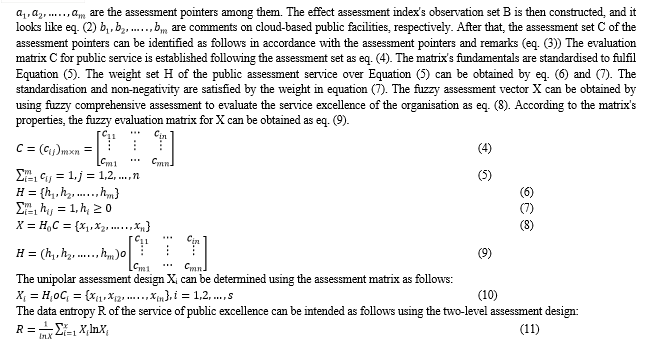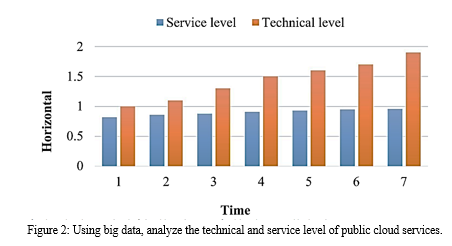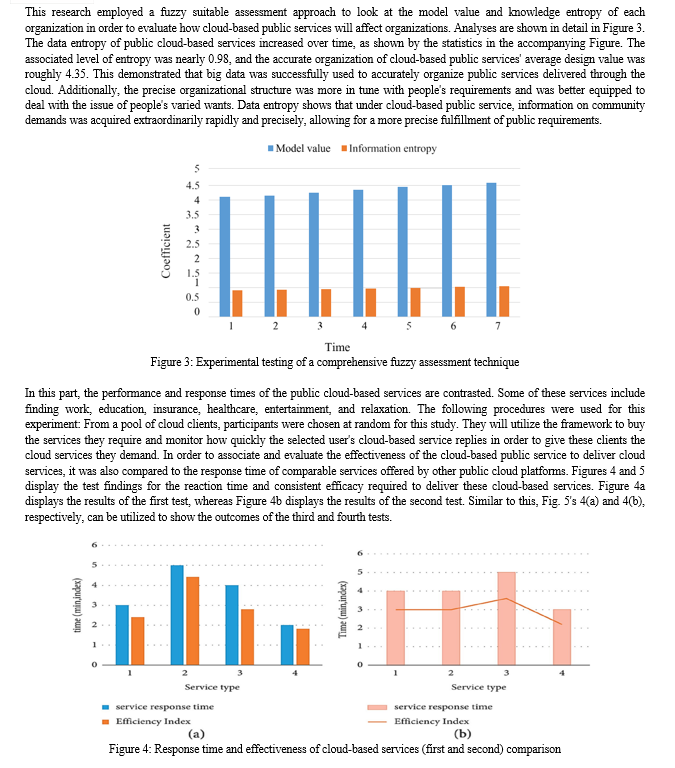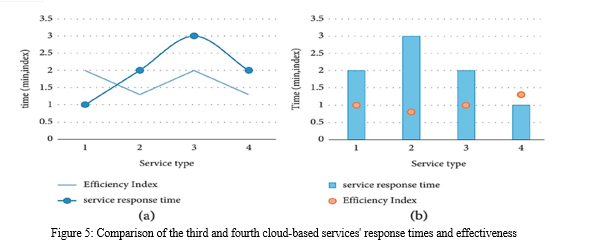Ijraset Journal For Research in Applied Science and Engineering Technology
- Home / Ijraset
- On This Page
- Abstract
- Introduction
- Conclusion
- References
- Copyright
A Methodological Study on Big Data and Cloud Computing for Public Policy Management
Authors: Samarth Naik
DOI Link: https://doi.org/10.22214/ijraset.2023.56118
Certificate: View Certificate
Abstract
The present study examines how big data and cloud computing have significantly impacted public service administration, resulting in increased productivity, data-driven decision-making, and higher-quality services across a range of industries. Predictive analytics made possible by big data revolutionizes healthcare by enabling public health organizations to effectively manage resources, anticipate health trends, and enhance patient care and public health outcomes. The combination of big data and cloud computing is poised to change public service management, enabling better responsiveness, efficiency, and alignment with public demands—even though data security, privacy concerns, and the need for competent data analysts remain. This study demonstrates the significant benefits of data-driven organizational design for public services by demonstrating how big data-driven cloud-based public services perform better than conventional techniques in terms of service delivery speed and accuracy. This study\'s main finding underscores how big data and cloud computing are transforming public service management fundamentally and have the ability to considerably increase responsiveness, efficiency, and alignment with the wide range of public needs.
Introduction
I. INTRODUCTION
According to research and analysis conducted to high standards, the overall operation of public management is not particularly pertinence, systematic, or integrated, despite improvements over the past and a positive trend. This is especially true when it comes to promoting effective integration, connection, and interaction between big data technology and public management, which directly causes a number of problems that cannot be ignored. In this regard, public management departments and managers should thoroughly comprehend the impact of big data on public management, perform analysis and demonstration on prominent problems faced by the Spark big data, identify any weak links currently in place, and take practical and effective measures to apply big data technology scientifically, methodically, and widely to public management. The public management technological conundrum primarily consists of three aspects: First, public management's confirmation technology is not ideal. According to public management theory, public value is a collection of public preferences, which introduces certain additional technical needs [1].
Since public preference is an ill-defined term, technology must be developed that can accurately gauge the level of public preference, including the public's potential or actual preference [5]. Even if this technology exists, the target audiences and topics chosen have effectively communicated to the public the issues they want to understand and the need for additional research and discussion. The ability to recognize and fulfill the public's shared will is essential to the success of urban development projects. However, identification technology's challenges may cause us to overlook crucial details, preventing the effect of producing public value from being maximized [6, 7]. Second, public value evaluation technology is not flawless. The appraisal of public value is still in its infancy and cannot be fully stated as big data technology advances and public policy evaluation technology advances in public management. Even though we can understand the relevance of abstract public values like procedural justice and government integrity, it might be challenging to examine them using data [8–10]. Even if the pertinent data are gathered, we must constantly develop and enhance our practices in order to ensure the data's authenticity and dependability. Third, the scale that can be utilized to measure performance using public value is not ideal. The construction of the government performance evaluation system must be value-oriented, including people-oriented, scientific development, serving the public, and five in one, which are consistent with the ideas and propositions of public management value [11–14]. Government performance management based on public value is a new paradigm of government performance governance. Technical assistance is required in this process for the development of the government assessment system, the design of the evaluation model, and the choice of evaluation indicators. We should thoroughly understand the influence of big data, which might produce the excellent results through the big data, and then encourage the reform and innovation of public management [15]. Recently, big data has been valued by a variety of disciplines and industries, indicating a trend of rapid development. In this sense, managers and departments responsible for public management should have a thorough understanding of the implications of big data technology and implement practical strategies to encourage its use in public administration.
In recent years, society has steadily built up a comprehensive national basic public service system that has improved technological proficiency and increased public satisfaction. Correctly serving the demand for public services has become a critical method for addressing the severe socioeconomic disparities that exist today and creating widespread prosperity in the new century. Big data, cloud computing, and artificial intelligence are just a few of the new information technologies that have emerged recently, making it more obvious than ever that digitization and digital services are the way of the future for business. More and more attention is being paid to the government's use of modern information technologies, such as big data, to understand and respond to the needs of the public for public services.
II. LITERATURE REVIEW
Stringent rules govern how public services are run as a platform for serving the public. The advantages of public administration experiments were articulated by James O, who also gave evidence of their rapidly shifting worth to theory and practice. He offered a full overview of the benefits of causal effects and the connections between experiments and public administration theory [1]. Mikel E presented a new paradigm based on a new open model to change the current approach to e-government. The design, production, and deployment of public services and mobile applications are the main objectives of the pattern, which is based on the collaboration of numerous stakeholders [2]. Glied S provided the patient with a wide range of public services, making certain that the hospital had the tools necessary to care for the patient and that the patient would have adequate resource protection [3]. Cheng Y looked into the elements that affect the participation of nonprofit organizations in public service planning and design. The results show that nonprofit organizations that are located in stable, resource-rich areas are more likely to participate in co-governance [4].
The novel approach proposed by G. Stojic can assist national, regional, and municipal governments in making choices about passenger public transportation and may also be utilized to define the scope and degree of a sustainable public transportation system [5]. To improve the quality of tourist-related public service in this area, Zheng Z selected the Beijing Tianjin Hebei region as the research backdrop and looked at the degree of public welfare activities and service quality there from the perspective of "global tourism" [16]. Gong J divided the influencing variables of public service into subjective and objective categories. The survey found that subjective factors have a big impact on how satisfied people are with the public sector [7]. The aforementioned studies do not use the data to administer public services, despite the fact that they discuss the worth of public services. Big data is a new technology with a wide range of uses. Hong X spoke on the appropriate practices and information for each level in terms of social function activities. Two viewpoints were used to study the use of big data in fine management: data collection and updating and data analysis application [8]. Fan X produced the most recent teacher information through cloud platform and used big data to identify the training object requests in order to collect quantitative data from teachers via multiple channels [9].
In order to discover different strategies that communities might employ as well as the possible advantages that big data can bring to enterprises in various economic sectors and functional areas within firms, Liu H analyzed the effects of big data on present public services and precision management [10]. Based on public service management, Li Z developed a trusted search without verification data security storage and sharing technique [11]. To improve the stability of the model in dynamic contexts, Cw A devised a divergence-based technique for assessing the quality of big data distribution [12]. Li S developed a large-scale searchable key-value storage system based on dynamic drives and researched a precise management service scheme that maps data to drives in order to reflect the metadata of actual data and satisfy users' attribute search expectations [13]. In order to improve the effectiveness and efficiency of decision-making, which improves both precise management and public service, Nisar Q A contends that data decision-making competency is crucial [14]. The precise role of big data in management has been defined in the aforementioned studies, however public service management still has several flaws.
III. BIG DATA IN MANAGING PUBLIC SERVICES
Big data has become an essential and revolutionary force in the management of public services, providing governments and public agencies with a strong and versatile instrument for enhancing productivity, decision-making, and citizen happiness. Big data applications span a wide range of fields, from healthcare and transportation to education and urban planning, and have a significant impact on how public services are managed. This paradigm shift makes use of the thorough gathering, curation, and analysis of enormous and diverse datasets to glean priceless insights, guide political choices, and improve the provision of public services.
Big data has had a profound impact on patient care and management in the field of healthcare. Public health organizations can proactively and accurately predict health trends and allocate resources with previously unheard-of precision by compiling and methodically analyzing health records, clinical data, and epidemiological information.
Additionally, big data's ability to enable predictive analytics can aid in illness surveillance, early intervention, and resource optimization, greatly decreasing the strain on healthcare systems and enhancing residents' general well-being. Another area where big data plays a crucial and game-changing role in optimizing public services is transportation, a vital aspect of contemporary urban living. Smart cities and transportation authorities regulate traffic flow, ease congestion, and improve public transit systems by utilizing data from a vast network of traffic sensors, GPS devices, and mobile applications. With the use of big data insights, public transportation organizations can design routes and anticipate peak times with amazing efficiency, improving service for commuters while also significantly reducing travel times and carbon emissions.
Big data is a crucial ally for innovation in education, enhancing learning results and streamlining administrative duties. Data analytics can be used by educational institutions to precisely identify at-risk pupils, modify teaching strategies, and allocate resources. Additionally, by evaluating how well schools, instructors, and curricula perform, governmental agencies can make data-driven policy changes that greatly improve the quality of education and support the future success of the nation's young. Big data has a favorable impact on urban planning and development, which is essential to societal advancement. With access to a variety of information on demographics, energy use, and the environment, city planners may create and oversee livable, environmentally friendly cities. Cities are better positioned for a sustainable and successful future because to this data-driven strategy, which produces superior infrastructure, lower energy consumption, and a much improved overall quality of life for urban populations.
Urban planning and development, which are crucial to social advancement, are positively impacted by big data. City planners are better able to design and manage livable, environmentally responsible communities if they have access to a wide range of data on demographics, energy use, and the environment. Thanks to this data-driven approach, which results in superior infrastructure, lower energy usage, and significantly higher overall quality of life for urban populations, cities are better prepared for a sustainable and prosperous future. It's important to recognize that while big data has a significant impact on how public services are managed, it also poses a number of challenging issues. To safeguard citizens' highly sensitive personal information, privacy issues and data security must be carefully addressed. In order to extract, understand, and communicate relevant insights from the enormous and complex datasets that are now available, there is a growing need for highly qualified data analysts and data scientists.
In summary, big data has ushered in a new era of public service management, providing governments and public agencies with previously unheard-of potential to enhance productivity, responsiveness, and the general caliber of services. Big data, when used wisely and effectively, can result in more informed choices that ultimately benefit individuals and society as a whole. Big data is expected to play an increasingly important and transformative role in modern governance and administration as technology advances. This will change the way public services are provided and bring significant benefits to societies all over the world.
IV. CLOUD COMPUTING IN MANAGING PUBLIC SERVICES
Governments and public organizations now have access to a potent and adaptable instrument for enhancing efficiency, accessibility, and the provision of services to citizens thanks to the cloud. This technology has emerged as a transformational force in the management of public services. The public sector's use of cloud computing is characterized by a move toward a more scalable, economical, and user-centric strategy. Cloud computing spans a wide range of applications across numerous areas, including healthcare, education, public safety, and administrative tasks, when considering its role in managing public services.
With applications in healthcare, education, public safety, and administration, cloud computing is a disruptive force in public service management. It facilitates real-time decision-making, improves data administration, and makes telemedicine possible in the healthcare industry. Cloud platforms in education enable remote learning, dissolving geographic constraints and fostering inclusivity. Rapid data sharing benefits public safety organizations by enhancing situational awareness and response times. Centralized operations improve the efficiency of administrative tasks. Although cloud computing has advantages in terms of scalability and cost-effectiveness, data security and equal access are serious issues. In conclusion, cloud computing transforms the management of public services by bringing efficiency and accessibility to a variety of fields.
The fuzzy suitable assessment approach is used to examine the performance of cloud-based services to determine how well they handle massive amounts of data. A fuzzy detailed assessment seeks to analyze the level of service offered by public organizations by developing an affiliation matrix. Building the pointer set A is the first step in developing the excellence of cloud-based public facilities, and it can be done as follows:


V. AMALGAMATION OF BIG DATA AND CLOUD COMPUTING
When combined, cloud computing and big data open up tremendous opportunities for a variety of applications. First, the combination of these technologies tackles the enormous storage and scalability concerns. Massive storage capacity is provided by cloud solutions, which is necessary to handle the enormous amounts of data generated and processed. This allays worries about physical infrastructure limitations and enables businesses to easily store and retrieve enormous datasets. Second, handling huge data workloads is made possible by cloud computing's elastic processing power feature. This dynamic resource allocation makes sure that enormous datasets are processed quickly and effectively, which speeds up data analysis.
Thirdly, a variety of data processing frameworks, including well-known ones like Apache Hadoop and Apache Spark, are supported by cloud computing platforms. These frameworks make use of the scalability and significant processing power of the cloud to enable the distributed and parallel analysis of large datasets. Tasks involving data processing and analysis are expedited by this combination.
Fourthly, a variety of analytics and machine learning tools and services are now widely accessible through cloud platforms as a result of the confluence of cloud and big data. These services give companies the tools they need to perform predictive analysis, create data-driven apps, and extract priceless knowledge from massive databases, improving data-driven innovation and decision-making.
Last but not least, the integration of big data with cloud computing enables the processing and analysis of high-velocity streaming data in real-time. The continuous analysis of data streams, which is essential for applications like fraud detection, Internet of Things (IoT) data processing, and recommendation systems, is made possible by cloud-based stream processing platforms like Apache Kafka. This real-time capacity not only improves the effectiveness of these apps but also creates new opportunities for organizations to take advantage of the potential of rapidly churning data streams for in-the-moment client engagement.
VI. METHODOLOGY & RESULTS
This research project evaluates the effect of precise organization on public cloud services that are affected by big data. Three societies in a city were the first ones that data-driven organizations looked at for their fulfillment. Each society had 150 members, and degrees of satisfaction were divided into three categories: Average, comfortable, and unsatisfied. The details of the survey results are displayed in Figure 1.

According to the statistics in the preceding Table, users in all three categories were generally happy with the quality of big data-driven cloud-based public services. 89.33% of respondents in Category 2, 85.33% of respondents in Category 3, and 84% of respondents in Category 1 reported feeling satisfied. Only 5.33% of the three categories were not satisfied, making for an overall satisfaction rate of 86.22%. Those in this category who were happy felt they could meet the majority of their cultural, living, and tourist needs since cloud-based public services can not only deliver tailored service contracts but also bring diversified and accurate services. Many people who weren't satisfied worried that their data would be tracked and maybe leaked, despite the fact that big data technology would monitor requirement data in real-time and send analytical conclusions to a massive database.
This study paper investigated the technological level and service level of cloud-based public service over the course of a week of practice to understand the influence of big data-driven cloud-based services on the public. Figure 2 shows the thorough analysis. The data in the aforementioned Figure demonstrates how the technical and service standards of public cloud-based services have increased over time. The seventh day was 0.9 better than the first in terms of technical level, with a mean of 1.44. The seventh day was 0.14 better than the first, with a mean service level of 0.90. The improvement in service quality and technical level demonstrated that big data-driven requirement recognition for cloud-based public services was more precise. It also demonstrated that it was possible to manage the quality of service for cloud-based public services by tracking service of public requirements in real-time.



According to these figures, public cloud-based services typically respond within 3.51 minutes, 4.52 minutes, 4.5 minutes, and 2.51 minutes, respectively.
This study examined the organizational advantages and overall effectiveness of the traditional correct organisation of cloud-based service publics in order to comprehend the genuine impact of the accurate organisation of cloud-based service publics powered by big data. The aforementioned graph shows that big data-driven accurate cloud-based service publics organization was more effective than conventional correct cloud-based service publics organization in terms of organizational effectiveness and overall efficacy. Organizational efficacy performed 7% better than conventional efficacy, and efficacy performed 9% better than conventional efficacy. Big data and the effectiveness of cloud-based services are leading to rapid improvements in public service. Using big data technologies for data gathering and recognition, a statistical study of the public's service demands was conducted. The goal is to aggregate the population's service requirements and then provide accurate organization based on those requirements. As a result, organizational accuracy may be effectively guaranteed, and the quality of public cloud-based services can be elevated.
Conclusion
This thorough examination explores how public service administration is changing, especially in light of big data and cloud computing. By integrating these technologies, governments and public agencies are now operating in a completely new way that improves productivity, decision-making, and overall service quality. It has changed a number of industries, including healthcare, transportation, education, and urban planning, improving the effectiveness of services and their responsiveness to customer demands. The research approach and findings made available here show the beneficial effects of big data-driven cloud-based public services. Users from a variety of categories usually expressed satisfaction with the services\' quality, demonstrating their ability to effectively address a range of demands. Technical and service levels examination revealed constant progress, with precise organization better aligned with public needs. Data entropy showed quick and accurate community demand gathering, resulting in more accurate service delivery. Big data-driven cloud services outperformed conventional approaches in performance and reaction time testing, providing quicker and more precise results. This illustrates the substantial advantages of data-driven organizational design for public services. Overall, this study highlights how big data and cloud computing have the ability to completely change how public services are managed, improving responsiveness, efficiency, and alignment with a range of public demands.
References
[1] Barrett, J. (2022). (n.d.). Up to 73% of Company Data Goes Unused for Analytics. Here’s How to Put It to Work. Inc. [2] Barton, D., & Court, D. (2012, October). Making Advanced Analytics Work For You. Harvard Business Review. Retrieved May 29, 2022 [3] Bennett, S. (2017). What is information governance and how does it differ from data governance. Governance Directions, Sep. 2017. [4] Bernal, I., Sejersen, T., Hansen, R. M., & Nyasulu, A. M. (2021). Big data for economic statistics. Stats Brief, UN ESCAP, Issue No. 28, March 2021. [5] Big Data Association (2019). Strategy for the Big Data market development by 2024. Retrieved May 29, 2022 [6] Columbus, L. (2015, October 17). Business Adopting Big Data, Cloud & Mobility Grow 53% Faster Than Peers. Forbes. Retrieved May 21, 2022 [7] Constatiou, I. D., & Kallinikos, J. (2015). New games, new rules: big data and the changing context of strategy. Journal of Information Technology, 30(1), 44–57. Davenport, T. H., & Dyché, J. (2013, May). Big Data in Big Companies. International Institute for Analytics. Retrieved May 23, 2022 [8] Decree of the President of the Russian Federation No (2017). 203 “Strategy of the Information Society Development in the Russian Federation for 2017–2030” [Document]: May 9, 2017 – Moscow. Collection of the Legislative Acts of the Russian Federation. No. 20. Art. 2901 [9] Dhamodharavadhani, S., Gowri, R., & Rathipriya, R. (2018, March). Conference: First International Conference on Computer Vision,Networks and Informatics Unlock Different V’s of Big Data for Analytics. International Journal of Computer Sciences and Engineering, 06 (04), 183–190. [10] Dremel, C., Herterich, M. M., Wulf, J., Waizmann, J. C., & Brenner, W. (2017). How AUDI AG Established Big Data Analytics in its Digital Transformation. MIS Quarterly Executive, vol. 16 (2), art. 3, 81–100. [11] Federal Tax Service (2020, November 12). Na obshchestvennom sovete pri FNS Rossii obsudili rabotu Sluzhby vo vremya pandemii [The Public Council of the Russian FTC discussed its work during the pandemic] Retrieved May 21, 2022 [12] Goasduff, L. (2020, September 18). How Data and Analytics Leaders Can Master Governance. Gartner. Retrieved May 22, 2022. [13] GOST R ISO/IEC 20546-2019. Information technology. Big data. Overview and vocabulary (2020). Federal Agency on Technical Regulating and Metrology. [14] GOST R 54524-2011/ISO/TS 8000-100:2009. Data quality. Part 100. Master data. Exchange of characteristic data. Overview (2012). Federal Agency on Technical Regulating and Metrology. [15] GOST R 56214-2014/ISO/TS 8000-1:2011. Data quality. Part 1. Overview (2015). Federal Agency on Technical Regulating and Metrology. [16] Gualtieri, M. (2016, January 21). Hadoop Is Data’s Darling For A Reason. Forrester. Retrieved May 22, 2022
Copyright
Copyright © 2023 Samarth Naik. This is an open access article distributed under the Creative Commons Attribution License, which permits unrestricted use, distribution, and reproduction in any medium, provided the original work is properly cited.

Download Paper
Paper Id : IJRASET56118
Publish Date : 2023-10-12
ISSN : 2321-9653
Publisher Name : IJRASET
DOI Link : Click Here
 Submit Paper Online
Submit Paper Online

